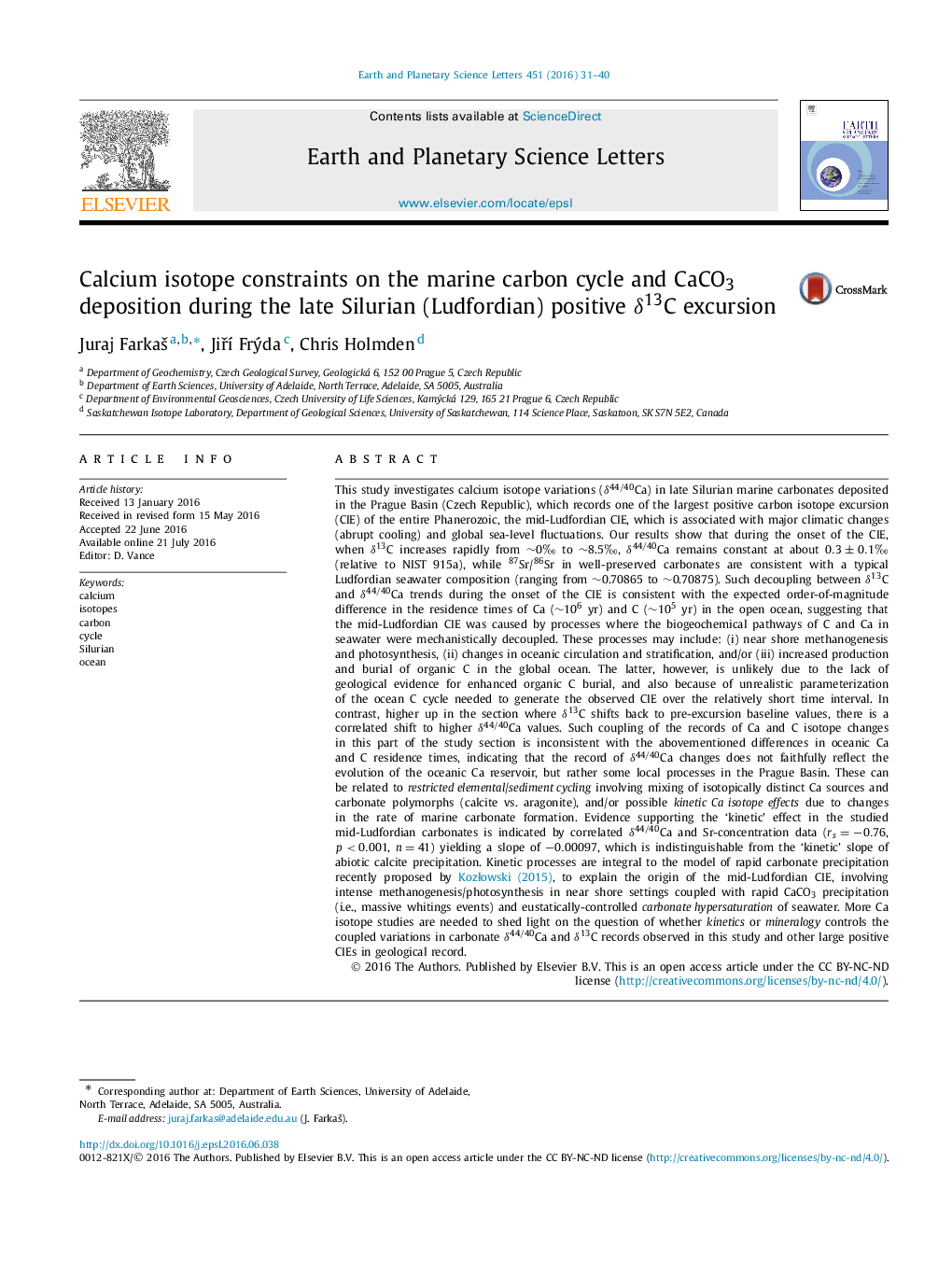| کد مقاله | کد نشریه | سال انتشار | مقاله انگلیسی | نسخه تمام متن |
|---|---|---|---|---|
| 6427245 | 1634705 | 2016 | 10 صفحه PDF | دانلود رایگان |

- A high-resolution Ca isotope record through the late Silurian C isotope excursion (CIE).
- This is the largest positive CIE in the Phanerozoic, reaching δ13C plateau of +8.5 per mil.
- δ44Ca and δ13C records from the Prague Basin are decoupled during the onset of this CIE.
- At the falling limb of the CIE we observe a coupling between Ca, C and Sr isotopes.
- Evidence for an overall 'kinetic' control of δ44Ca variations in the studied carbonates.
This study investigates calcium isotope variations (δ44/40Ca) in late Silurian marine carbonates deposited in the Prague Basin (Czech Republic), which records one of the largest positive carbon isotope excursion (CIE) of the entire Phanerozoic, the mid-Ludfordian CIE, which is associated with major climatic changes (abrupt cooling) and global sea-level fluctuations. Our results show that during the onset of the CIE, when δ13C increases rapidly from â¼0â° to â¼8.5â°, δ44/40Ca remains constant at about 0.3±0.1â° (relative to NIST 915a), while 87Sr/86Sr in well-preserved carbonates are consistent with a typical Ludfordian seawater composition (ranging from â¼0.70865 to â¼0.70875). Such decoupling between δ13C and δ44/40Ca trends during the onset of the CIE is consistent with the expected order-of-magnitude difference in the residence times of Ca (â¼106yr) and C (â¼105yr) in the open ocean, suggesting that the mid-Ludfordian CIE was caused by processes where the biogeochemical pathways of C and Ca in seawater were mechanistically decoupled. These processes may include: (i) near shore methanogenesis and photosynthesis, (ii) changes in oceanic circulation and stratification, and/or (iii) increased production and burial of organic C in the global ocean. The latter, however, is unlikely due to the lack of geological evidence for enhanced organic C burial, and also because of unrealistic parameterization of the ocean C cycle needed to generate the observed CIE over the relatively short time interval. In contrast, higher up in the section where δ13C shifts back to pre-excursion baseline values, there is a correlated shift to higher δ44/40Ca values. Such coupling of the records of Ca and C isotope changes in this part of the study section is inconsistent with the abovementioned differences in oceanic Ca and C residence times, indicating that the record of δ44/40Ca changes does not faithfully reflect the evolution of the oceanic Ca reservoir, but rather some local processes in the Prague Basin. These can be related to restricted elemental/sediment cycling involving mixing of isotopically distinct Ca sources and carbonate polymorphs (calcite vs. aragonite), and/or possible kinetic Ca isotope effects due to changes in the rate of marine carbonate formation. Evidence supporting the 'kinetic' effect in the studied mid-Ludfordian carbonates is indicated by correlated δ44/40Ca and Sr-concentration data (rs=â0.76, p<0.001, n=41) yielding a slope of â0.00097, which is indistinguishable from the 'kinetic' slope of abiotic calcite precipitation. Kinetic processes are integral to the model of rapid carbonate precipitation recently proposed by KozÅowski (2015), to explain the origin of the mid-Ludfordian CIE, involving intense methanogenesis/photosynthesis in near shore settings coupled with rapid CaCO3 precipitation (i.e., massive whitings events) and eustatically-controlled carbonate hypersaturation of seawater. More Ca isotope studies are needed to shed light on the question of whether kinetics or mineralogy controls the coupled variations in carbonate δ44/40Ca and δ13C records observed in this study and other large positive CIEs in geological record.
Journal: Earth and Planetary Science Letters - Volume 451, 1 October 2016, Pages 31-40